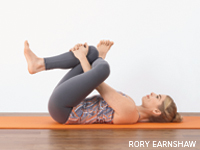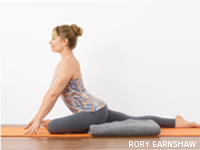
 Yoga handles stiff hips in a variety of ways, but most directly through a family of poses that are known loosely as “hip openers.” Some hip openers increase the external, or outward, rotation of the femur bone in the hip socket. Others lengthen the psoas muscle, a primary hip flexor connecting the torso and legs that gets chronically shortened in our chair-bound society. Pigeon Pose is an extremely effective hip opener that addresses both areas, with the front leg working in external rotation and the back leg in position to stretch the psoas.
Yoga handles stiff hips in a variety of ways, but most directly through a family of poses that are known loosely as “hip openers.” Some hip openers increase the external, or outward, rotation of the femur bone in the hip socket. Others lengthen the psoas muscle, a primary hip flexor connecting the torso and legs that gets chronically shortened in our chair-bound society. Pigeon Pose is an extremely effective hip opener that addresses both areas, with the front leg working in external rotation and the back leg in position to stretch the psoas.
Pigeon is actually a variation of the advanced pose, Eka Pada Rajakapotasana (One-Legged King Pigeon Pose). The two poses share similar alignment in the hips and, more important, an imperative to be approached thoughtfully and consciously. Most practitioners recognize that One-Legged King Pigeon is an advanced backbend that requires precise alignment. Yet many of us are likely to thoughtlessly fold into the forward-bend variation of Pigeon, which can put a lot of stress on the knee and sacrum. To avoid injury, I approach Pigeon by first doing variations that will open the hips gradually and safely. Once your hips are open, you’ll be able to craft a well-balanced Pigeon that benefits your hips and lower back. If you practice it consistently, you’ll notice more ease in your lower half as you sit, walk, and stand.
 Pose Benefits:
Pose Benefits:
- Increases external range of motion of femur in hip socket
- Lengthens hip flexors
- Prepares body for backbends
Contraindications:
- Knee injury
- Sacroiliac issues
1. Thread the Needle
One of the best ways to open the hips and prepare for Pigeon is through a supine modification called Eye of the Needle (sometimes called Dead Pigeon). I teach this pose to first timers and practice it myself on a regular basis. As you move through this and the next variation, and then toward the final pose, make sure that you alternate sides so that your body can unfold evenly and progressively.
To begin, come onto your back with your knees bent and your thighs parallel and hip-distance apart. Next, cross your left ankle over your right thigh, making sure that your anklebone clears your thigh. Actively flex your front foot by pulling your toes back. When you do this, the center of your foot will line up with your kneecap rather than curving into a sickle shape, which can stress the ligaments of the ankle and the knee.









